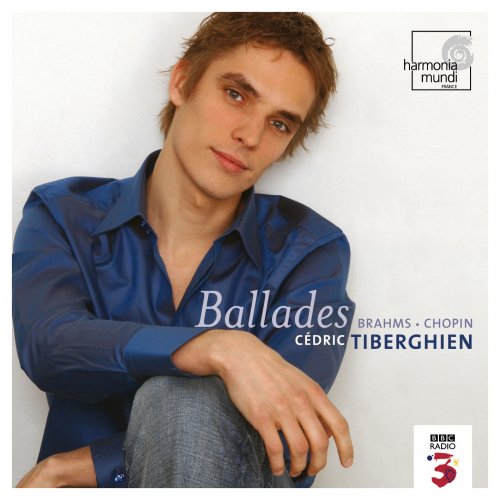
Cédric Tiberghien - Ballades: Brahms, Chopin (2006)
BAND/ARTIST: Cédric Tiberghien
- Title: Ballades: Brahms, Chopin
- Year Of Release: 2006
- Label: Harmonia Mundi
- Genre: Classical
- Quality: FLAC (tracks)
- Total Time: 59:51
- Total Size: 171 Mb
- WebSite: Album Preview
Tracklist:
1. Ballade N°1 Op.23
2. Ballade N°2 Op.38
3. N°1. Andante
4. N°2 Andante
5. N°3 Intermezzo
6. N°4 Andante Con Moto
7. Ballade N°3 Op.47. Allegretto
8. Ballade N°4 Op.52. Andante Con Moto
Performers:
Piano – Cédric Tiberghien
1. Ballade N°1 Op.23
2. Ballade N°2 Op.38
3. N°1. Andante
4. N°2 Andante
5. N°3 Intermezzo
6. N°4 Andante Con Moto
7. Ballade N°3 Op.47. Allegretto
8. Ballade N°4 Op.52. Andante Con Moto
Performers:
Piano – Cédric Tiberghien
For his program celebrating the “twin peaks of the Romantic Ballade”, Cédric Tiberghien brackets Brahms’ Op. 10 set with Chopin’s First and Second on one end plus the Third and Fourth on the other. The pianist’s best work occurs in the Chopin selections. Although Tiberghien underplays many of the First Ballade’s softer passages (the introduction, the first statement of the second theme, for example), he brilliantly rises to its bravura demands. He treats the main theme’s return before the coda in an unusually frenzied fashion, and in the coda proper he takes the declamatory octave unison lines in strict tempo.
In the Second Ballade, Tiberghien’s lilting simplicity in the outer sections contrasts to his driving, steel-edged articulation of the agitated sequences. True, he doesn’t brutalize the latter à la Freddy Kempf and Jerome Rose, but I’d have preferred a less “notey”, larger sense of line and shape (e.g., Ivan Moravec, Murray Perahia, and Cyprien Katsaris).
While Tiberghien’s fluent, prettified Third Ballade satisfies without being particularly memorable, his intelligent dynamic scaling and extremely subtle rubatos in the Fourth create an unfolding, unified narrative that does Chopin full compositional and pianistic justice.
By and large, Tiberghien makes a more generalized and sometimes bland impression in the Brahms Ballades. A lot of this has to do with overlooking simple details, such as anticipating the pianissimo “echo” effect two notes too soon in No. 1’s opening theme, laying upon No. 2’s middle-section marcato eighth notes too heavily, or undermining Brahms’ signature cross-rhythms by slightly rushing the rests in No. 3 (measure 13, for example).
It’s one thing to play No. 4’s opening pages with more emphasis on “con moto” than “andante”, but it’s quite another for Tiberghien to only bring out the melody while strumming the descending arpeggiated accompanimental figure in a vaporous manner more appropriate to George Winston. The central piu lento fares better yet still falls short of the concentration and linear tension that pianists as different as Arturo Benedetti Michelangeli, Glenn Gould, and Lars Vogt convey. Harmonia Mundi’s engineering is slightly strident in loud passages but will satisfy those who enjoy ample bass response from piano recordings.
In the Second Ballade, Tiberghien’s lilting simplicity in the outer sections contrasts to his driving, steel-edged articulation of the agitated sequences. True, he doesn’t brutalize the latter à la Freddy Kempf and Jerome Rose, but I’d have preferred a less “notey”, larger sense of line and shape (e.g., Ivan Moravec, Murray Perahia, and Cyprien Katsaris).
While Tiberghien’s fluent, prettified Third Ballade satisfies without being particularly memorable, his intelligent dynamic scaling and extremely subtle rubatos in the Fourth create an unfolding, unified narrative that does Chopin full compositional and pianistic justice.
By and large, Tiberghien makes a more generalized and sometimes bland impression in the Brahms Ballades. A lot of this has to do with overlooking simple details, such as anticipating the pianissimo “echo” effect two notes too soon in No. 1’s opening theme, laying upon No. 2’s middle-section marcato eighth notes too heavily, or undermining Brahms’ signature cross-rhythms by slightly rushing the rests in No. 3 (measure 13, for example).
It’s one thing to play No. 4’s opening pages with more emphasis on “con moto” than “andante”, but it’s quite another for Tiberghien to only bring out the melody while strumming the descending arpeggiated accompanimental figure in a vaporous manner more appropriate to George Winston. The central piu lento fares better yet still falls short of the concentration and linear tension that pianists as different as Arturo Benedetti Michelangeli, Glenn Gould, and Lars Vogt convey. Harmonia Mundi’s engineering is slightly strident in loud passages but will satisfy those who enjoy ample bass response from piano recordings.
As a ISRA.CLOUD's PREMIUM member you will have the following benefits:
- Unlimited high speed downloads
- Download directly without waiting time
- Unlimited parallel downloads
- Support for download accelerators
- No advertising
- Resume broken downloads


